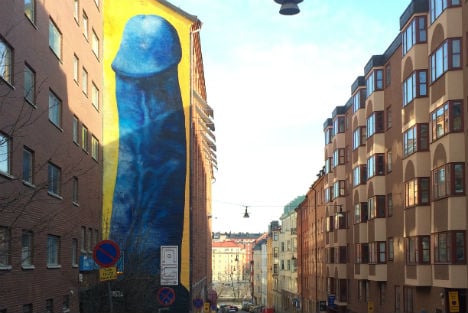ART
Stockholm’s giant penis mural to be covered up after complaints
A giant blue penis painted on a Stockholm apartment building is to be covered up after just one week, the company which owns the building has said.
Published: 13 April 2018 09:52 CEST

The penis was painted in blue with a yellow background, perhaps reflecting Sweden's national colours. Photo: Photo: Hugo Röjgård/Graffitifrämjandet
Atrium Ljungberg said it had come to the decision after receiving a barrage of complaints about the five-story high depiction of a bulging erection.
“Of course we care about artistic freedom, but at the same time we must respect the opinion of our closest neighbours,” Camilla Klint, the company's marketing head, said in a statement.
“By letting it remain for a short period, we are offering anyone who's interested a chance to experience the work.”
The company said that it had been given no prior warning that a giant penis was about to appear on one of its blocks.
“On Wednesday morning, April 11th, we saw Kollektivet Livet's new work for the first time, at exactly the same moment as all the other people who live on Kungsholmen did,” it said in its statement.
Under their arrangement, the artist collective had total artistic freedom over the works it commissioned for the wall, at Kronobergsgatan 35 on the central Stockholm island of Kungsholmen.
The decision will come as a disappointment to the artist Carolina Falkholt. Her first giant penis painting, which she plastered on a wall in the Lower East Side of Manhattan in December, lasted only a few days.
She said on Wednesday that she expected her native Swedes to be more receptive.
Atrium Ljungberg did acknowledge that many appreciated the painting.
“Some people are positive about the work and see it as playing an important part in the debate around sexuality, the body and gender,” the company wrote.
“Others, particularly neighbours, have received the work less well, and experience it as offensive.”
Url copied to clipboard!


 Please whitelist us to continue reading.
Please whitelist us to continue reading.
So how does a realistic image of a male sexual instrument that everybody has seen a version of contribute to a debate on sexuality? Crass comment by Atrium Ljungberg. It is simply a piece of attention-seeking journalism with zero artistic content…my opinion of course
Personally, I’d have liked to have seen a giant vagina. There are already too many big pricks in the world as it is.
Have to admit if i had to see that every time i looked outside id be a little upset . In total agreement with the people who have to put up with that. How would you explain that to your kids every time you walked past? Not to mention the elderly who are of a different generation. New Zealand is a liberal country but no way would that be allowed here so totally understand Swedens point.A little modesty isn’t a bad thing.
Have to admit if i had to see that every time i looked outside id be a little upset . In total agreement with the people who have to put up with that. How would you explain that to your kids every time you walked past? Not to mention the elderly who are of a different generation. New Zealand is a liberal country but no way would that be allowed here so totally understand Swedens point.A little modesty isn’t a bad thing.
Have to admit if i had to see that every time i looked outside id be a little upset . In total agreement with the people who have to put up with that. How would you explain that to your kids every time you walked past? Not to mention the elderly who are of a different generation. New Zealand is a liberal country but no way would that be allowed here so totally understand Swedens point.A little modesty isn’t a bad thing.
Have to admit if i had to see that every time i looked outside id be a little upset . In total agreement with the people who have to put up with that. How would you explain that to your kids every time you walked past? Not to mention the elderly who are of a different generation. New Zealand is a liberal country but no way would that be allowed here so totally understand Swedens point.A little modesty isn’t a bad thing.
@Made in Britain – if you are in Stockholm and you go to Slussen station, you will see that some of the tunnelbana art is indeed vaginal. On at least one of the platforms there are simple black and white line drawings with red splodges in the relevant spots. It’s not on such a dramatic scale as Kungsholmen’s Big Blue – but it’s quite arresting and I’ve seen many people double-taking when they notice it.
independent escorts in delhi